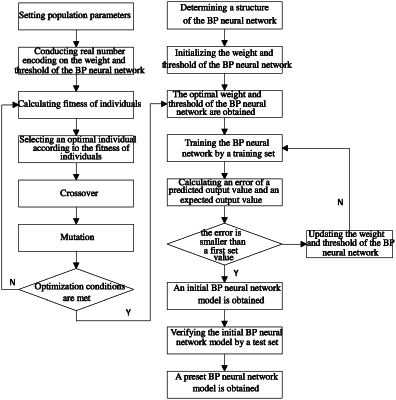| CPC G06N 3/084 (2013.01) [G06N 3/04 (2013.01); G06N 3/082 (2013.01); G06N 3/126 (2013.01); G06N 5/022 (2013.01); G10L 25/03 (2013.01); G10L 25/30 (2013.01); G10L 25/51 (2013.01)] | 6 Claims |

|
1. A prediction method for rock mass instability stages, comprising the steps:
acquiring acoustic emission signals of rock mass obtained from one or more sensors;
extracting feature parameters from the acquired acoustic emission signals; and
predicting instability stages of the rock mass in accordance with the feature parameters and a preset back propagation (BP) neural network model, wherein the preset BP neural network model is obtained by training a BP neural network and a genetic algorithm by virtue of the feature parameters of the acoustic emission signals at different rock mass instability stages;
wherein extracting feature parameters from the acquired acoustic emission signals comprises: dividing the acoustic emission signals acquired in the rock mass instability process into four stages according to rock mass stress conditions as follows:
a stage I compaction stage;
a stage II elastic deformation stage;
a stage III plastic deformation stage; and
a stage IV post-peak failure stage; and
extracting feature parameters from the acoustic emission signals at the four stages respectively;
wherein a training process of the preset BP neural network model comprises the following steps:
acquiring acoustic emission signals of different rock mass instability stages and extracting feature parameters of the acoustic emission signals of different rock mass instability stages;
dividing all the extracted feature parameters of the acoustic emission signals of different rock mass instability stages into a training set and a test set;
training the BP neural network in accordance with the training set and the genetic algorithm so as to obtain an initial BP neural network model; and
verifying the initial BP neural network model according to the test set, thereby obtaining the preset BP neural network model;
wherein a process of obtaining the initial BP neural network model comprises the steps:
determining the number of nodes in an input layer and an output layer of the BP neural network model in accordance with categories of the feature parameters in the training set and the rock mass instability stages;
determining the number of nodes in a hidden layer of the BP neural network in accordance with cut-and-trial;
initializing a weight and a threshold of the BP neural network;
optimizing the weight and threshold of the BP neural network by virtue of the genetic algorithm; and
training the BP neural network in accordance with the feature parameters in the training set and the corresponding rock mass instability stages, acquiring an error between a predicted output value and an expected output value of the BP neural network, and updating the weight and the threshold of the BP neural network by virtue of back propagation until the error between the predicted output value and the expected output value is smaller than a first set value, thereby obtaining the initial BP neural network model,
wherein a process of optimizing the weight and threshold of the BP neural network by virtue of the genetic algorithm comprises the steps:
setting population parameters comprising population size, evolution frequency, crossover probability and mutation probability;
conducting real number encoding on parameters of the BP neural network to obtain chromosome individuals, wherein the parameters comprise the weight and the threshold of the BP neural network, a length of each of the chromosome individuals meets the following formula: L=n×m+m×s+m+s, wherein L is the chromosome length; n is the number of nodes in the input layer; m is the number of nodes in the output layer; and s is the number of nodes in the hidden layer; and
calculating fitness of individuals, selecting an optimal individual from the current population according to the fitness of individuals, executing crossover and mutation operations until optimization conditions are met to obtain optimum weight and threshold, and using the optimum weight and threshold to update the initial weight and threshold of the BP neural network.
|